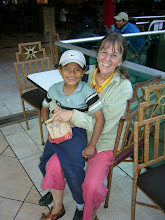
I have been feeling lately that I am witnessing the Death of Culture, here.....mainly because the little girls are not always wearing the traditional clothing any more, but wearing sports clothes, instead. And today at a lovely celebration of Las Abuelitas (the little grandmothers) in San Juan, where we were testing reading in the public school, the school boys were playing around, ignoring the ceremonies and being interruptive. Which is just boys, of course, but usually in Guate I've seen them being very respectful.....kissing the hands of the older men as they pass them, for instance. That has always touched me.
So today I was watching the Dia de las Abuelitas ceremony, during a break. There were probably 50 older women in full traditional dress (traje) sitting on one side of the audience and 40 or so men sitting on the other side, all the men wearing the usual sort of man's hat, but white straw with a black band, and maybe 18 or so wearing full traje (see inset photo of girl and boy in local traje like their elders'....however this is a San Pablo foto, and the style is different. I'll find the one I want one of these days!)
The six older women being honored that day danced with their spouses (presumably) up to the stage in the usual 1-2-3, 1-2-3 step to marimba music and the men then tipped their hats and bowed to the women sitting on the stage and left each woman in her seat of honor. The women gave speeches in Tz'utujil in which "maktiosh" (thank you) appeared prominently.
Then some of the women danced together with the same step in couple posture.
It all seemed incredibly sweet to me.
But I can imagine how it might look to the young kids, who aren't interested in laboring in the fields or over a backstrap loom, as their grandparents and parents did or still do; who look to tv (what little they may see) to define the world for them: "Those old people, who no longer have wisdom to offer us, who wear those silly clothes...."
Sometimes I fantasize that the presence of us Americans, who like to wear the traje (I just happened to have a venerated huipile from San Juan on today with a local textile skirt,) and who love to work in the garden, if not the field, might be a different example...at least for those few who revere the old ways, and there will always be a few - like me - who revere honest physical labor, who love weaving, and a relationship with the soil and plant life and the weather.
But of course culture is ever-changing, and has been "dying," here, since before La Violencia. One anthropologist dates it to the time when the younger men didn't want to "spend" their money, hard-earned on the distant fincas or in the city, in the traditional way--by throwing big fiestas for todo el pueblo which cost everything they had--the ancient culture's way of levelling the playing field, establishing non-material status, and avoiding jealousy over material goods.
(See the wonderful book, Violent Memories by Judith Zur, which is about so much more than the war years.)
















